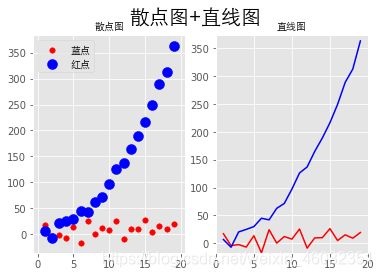文章目录
- Python常用模块
-
- time模块
-
- 时间戳
- 格式化时间
- 结构化时间
- 不同格式时间的转换
- 其他用法
- datetime模块
- random模块
- os模块
- sys模块
- json和pickle模块
-
- hashlib模块
-
- logging模块
-
- numpy模块
-
- 创建矩阵
- 获取矩阵的行列数
- 切割矩阵
- 矩阵元素替换
- 矩阵的合并
- 通过函数创建矩阵
-
- arange
- linspace/logspace
- zeros/ones/eye/empty
- fromstring/fromfunction
- 矩阵的运算
-
- 矩阵的点乘
- 矩阵的转置
- 矩阵的逆
- 矩阵其他操作
-
- 最大最小值
- 平均值
- 方差
- 标准差
- 中位数
- 矩阵求和
- 累加和
- numpy.random生成随机数
- pandas模块
-
- Series
- DataFrame
- DataFrame属性
- DataFrame取值
-
- DataFrame值替换
- 读取CSV文件
- 处理丢失数据
- 导入导出数据
- 合并数据
- 读取sql语句
- matplotlib模块
-
Python常用模块
time模块
import time
时间戳
时间戳(timestamp):时间戳表示的是从1970年1月1日00:00:00开始按秒计算的偏移量。
time_stamp = time.time()
print(time_stamp, type(time_stamp))
1552551519.291029
格式化时间
格式化的时间字符串(format string):格式化时间表示的是普通的字符串格式的时间。
format_time = time.strftime("%Y-%m-%d %X")
print(format_time, type(format_time))
2019-03-07 16:22:11
结构化时间
结构化的时间(struct time):struct_time元组共有9个元素共九个元素,分别为(年,月,日,时,分,秒,一年中第几周,一年中第几天,夏令时)
print('本地时区的struct_time:\n{}'.format(time.localtime()))
print('UTC时区的struct_time:\n{}'.format(time.gmtime()))
本地时区的struct_time:
time.struct_time(tm_year=2019, tm_mon=3, tm_mday=7, tm_hour=16, tm_min=22, tm_sec=11, tm_wday=3, tm_yday=66, tm_isdst=0)
UTC时区的struct_time:
time.struct_time(tm_year=2019, tm_mon=3, tm_mday=7, tm_hour=8, tm_min=22, tm_sec=11, tm_wday=3, tm_yday=66, tm_isdst=0)
print(time.localtime(0))
time.struct_time(tm_year=1970, tm_mon=1, tm_mday=1, tm_hour=8, tm_min=0, tm_sec=0, tm_wday=3, tm_yday=1, tm_isdst=0)
print(time.localtime(3600*24*365))
time.struct_time(tm_year=1971, tm_mon=1, tm_mday=1, tm_hour=8, tm_min=0, tm_sec=0, tm_wday=4, tm_yday=1, tm_isdst=0)
不同格式时间的转换
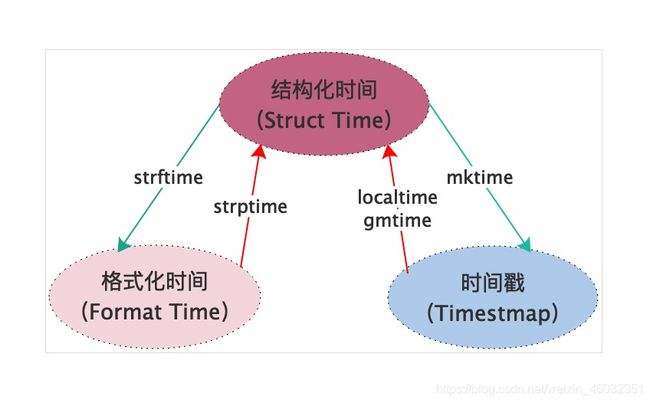
如上图所示,我们总能通过某些方法在结构化时间-格式化时间-时间戳三者之间进行转换,下面我们将用代码展示如何通过这些方法转换时间格式。
now_time = time.localtime()
print(now_time)
time.struct_time(tm_year=2019, tm_mon=3, tm_mday=7, tm_hour=16, tm_min=22, tm_sec=11, tm_wday=3, tm_yday=66, tm_isdst=0)
print(time.mktime(now_time))
1551946931.0
print(time.strftime("%Y-%m-%d %X", now_time))
2019-03-07 16:22:11
print(time.strptime('2013-05-20 13:14:52', '%Y-%m-%d %X'))
time.struct_time(tm_year=2013, tm_mon=5, tm_mday=20, tm_hour=13, tm_min=14, tm_sec=52, tm_wday=0, tm_yday=140, tm_isdst=-1)
print(time.asctime())
Thu Mar 7 16:22:11 2019
print(time.asctime(time.localtime()))
Thu Mar 7 16:22:11 2019
print(time.ctime())
Thu Mar 7 16:22:11 2019
print(time.ctime(time.time()))
Thu Mar 7 16:22:11 2019
其他用法
start = time.time()
time.sleep(3)
end = time.time()
print(end-start)
3.0005428791046143
datetime模块
import datetime
print(datetime.datetime.now())
2019-03-07 16:22:14.544130
print(datetime.date.fromtimestamp(time.time()))
2019-03-07
print(datetime.datetime.now() + datetime.timedelta(3))
2019-03-10 16:22:14.560599
print(datetime.datetime.now() + datetime.timedelta(-3))
2019-03-04 16:22:14.568473
print(datetime.datetime.now() + datetime.timedelta(hours=3))
2019-03-07 19:22:14.575881
print(datetime.datetime.now() + datetime.timedelta(minutes=30))
2019-03-07 16:52:14.585432
c_time = datetime.datetime.now()
print(c_time.replace(minute=20, hour=5, second=13))
2019-03-07 05:20:13.595493
random模块
import random
print(random.random())
0.25435092120631386
print(random.randint(1, 3))
2
print(random.randrange(1, 3))
1
print(random.uniform(1, 3))
2.718804989532962
print(random.choice([1, '23', [4, 5]]))
1
print(random.sample([1, '23', [4, 5]], 2))
[[4, 5], '23']
lis = [1, 3, 5, 7, 9]
random.shuffle(lis)
print(lis)
[1, 3, 9, 7, 5]
os模块
os模块负责程序与操作系统交互。
| 方法 |
详解 |
| os.getcwd() |
获取当前工作目录,即当前python脚本工作的目录路径 |
| os.chdir(“dirname”) |
改变当前脚本工作目录;相当于shell下cd |
| os.curdir |
返回当前目录: (’.’) |
| os.pardir |
获取当前目录的父目录字符串名:(’…’) |
| os.makedirs(‘dirname1/dirname2’) |
可生成多层递归目录 |
| os.removedirs(‘dirname1’) |
若目录为空,则删除,并递归到上一级目录,如若也为空,则删除,依此类推 |
| os.mkdir(‘dirname’) |
生成单级目录;相当于shell中mkdir dirname |
| os.rmdir(‘dirname’) |
删除单级空目录,若目录不为空则无法删除,报错;相当于shell中rmdir dirname |
| os.listdir(‘dirname’) |
列出指定目录下的所有文件和子目录,包括隐藏文件,并以列表方式打印 |
| os.remove() |
删除一个文件 |
| os.rename(“oldname”,“newname”) |
重命名文件/目录 |
| os.stat(‘path/filename’) |
获取文件/目录信息 |
| os.sep |
输出操作系统特定的路径分隔符,win下为"\",Linux下为"/" |
| os.linesep |
输出当前平台使用的行终止符,win下为"\t\n",Linux下为"\n" |
| os.pathsep |
输出用于分割文件路径的字符串 win下为;,Linux下为: |
| os.name |
输出字符串指示当前使用平台。win->‘nt’; Linux->‘posix’ |
| os.system(“bash command”) |
运行shell命令,直接显示 |
| os.environ |
获取系统环境变量 |
| os.path.abspath(path) |
返回path规范化的绝对路径 |
| os.path.split(path) |
将path分割成目录和文件名二元组返回 |
| os.path.dirname(path) |
返回path的目录。其实就是os.path.split(path)的第一个元素 |
| os.path.basename(path) |
返回path最后的文件名。如何path以/或\结尾,那么就会返回空值。即os.path.split(path)的第二个元素 |
| os.path.exists(path) |
如果path存在,返回True;如果path不存在,返回False |
| os.path.isabs(path) |
如果path是绝对路径,返回True |
| os.path.isfile(path) |
如果path是一个存在的文件,返回True。否则返回False |
| os.path.isdir(path) |
如果path是一个存在的目录,则返回True。否则返回False |
| os.path.join(path1[, path2[, …]]) |
将多个路径组合后返回,第一个绝对路径之前的参数将被忽略 |
| os.path.getatime(path) |
返回path所指向的文件或者目录的最后存取时间 |
| os.path.getmtime(path) |
返回path所指向的文件或者目录的最后修改时间 |
os.path.getsize(path) 返回path的大小
sys模块
sys模块负责程序与Python解释器进行交互。
| 方法 |
详解 |
| sys.argv |
命令行参数List,第一个元素是程序本身路径 |
| sys.modules.keys() |
返回所有已经导入的模块列表 |
| sys.exc_info() |
获取当前正在处理的异常类,exc_type、exc_value、exc_traceback当前处理的异常详细信息 |
| sys.exit(n) |
退出程序,正常退出时exit(0) |
| sys.hexversion |
获取Python解释程序的版本值,16进制格式如:0x020403F0 |
| sys.version |
获取Python解释程序的版本信息 |
| sys.maxint |
最大的Int值 |
| sys.maxunicode |
最大的Unicode值 |
| sys.modules |
返回系统导入的模块字段,key是模块名,value是模块 |
| sys.path |
返回模块的搜索路径,初始化时使用PYTHONPATH环境变量的值 |
| sys.platform |
返回操作系统平台名称 |
| sys.stdout |
标准输出 |
| sys.stdin |
标准输入 |
| sys.stderr |
错误输出 |
| sys.exc_clear() |
用来清除当前线程所出现的当前的或最近的错误信息 |
| sys.exec_prefix |
返回平台独立的python文件安装的位置 |
| sys.byteorder |
本地字节规则的指示器,big-endian平台的值是’big’,little-endian平台的值是’little’ |
| sys.copyright |
记录python版权相关的东西 |
| sys.api_version |
解释器的C的API版本 |
json和pickle模块
序列化
把对象(变量)从内存中变成可存储或传输的过程称之为序列化,在Python中叫pickling,在其他语言中也被称之为serialization,marshalling,flattening。
序列化的优点:
- 持久保存状态:内存是无法永久保存数据的,当程序运行了一段时间,我们断电或者重启程序,内存中关于这个程序的之前一段时间的数据(有结构)都被清空了。但是在断电或重启程序之前将程序当前内存中所有的数据都保存下来(保存到文件中),以便于下次程序执行能够从文件中载入之前的数据,然后继续执行,这就是序列化。
- 跨平台数据交互:序列化时不仅可以把序列化后的内容写入磁盘,还可以通过网络传输到别的机器上,如果收发的双方约定好实用一种序列化的格式,那么便打破了平台/语言差异化带来的限制,实现了跨平台数据交互。
json
Json序列化并不是python独有的,json序列化在java等语言中也会涉及到,因此使用json序列化能够达到跨平台传输数据的目的。
json数据类型和python数据类型对应关系表
| Json类型 |
Python类型 |
| {} |
dict |
| [] |
list |
| “string” |
str |
| 520.13 |
int或float |
| true/false |
True/False |
| null |
None |
json模块序列化和反序列化的一个过程如下图所示
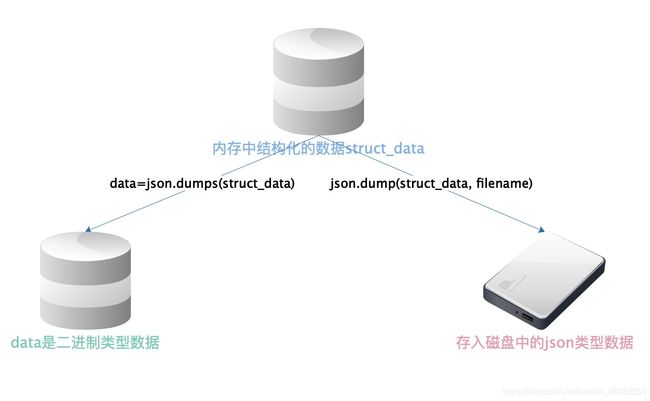
import json
struct_data = {
'name': 'json', 'age': 23, 'sex': 'male'}
print(struct_data, type(struct_data))
{'name': 'json', 'age': 23, 'sex': 'male'}
data = json.dumps(struct_data)
print(data, type(data))
{"name": "json", "age": 23, "sex": "male"}
data = json.loads(data)
print(data, type(data))
{'name': 'json', 'age': 23, 'sex': 'male'}
with open('Json序列化对象.json', 'w') as fw:
json.dump(struct_data, fw)
with open('Json序列化对象.json') as fr:
data = json.load(fr)
print(data)
{'name': 'json', 'age': 23, 'sex': 'male'}
pickle
Pickle序列化和所有其他编程语言特有的序列化问题一样,它只能用于Python,并且可能不同版本的Python彼此都不兼容,因此,只能用Pickle保存那些不重要的数据,即不能成功地反序列化也没关系。但是pickle的好处是可以存储Python中的所有的数据类型,包括对象,而json不可以。
pickle模块序列化和反序列化的过程如下图所示
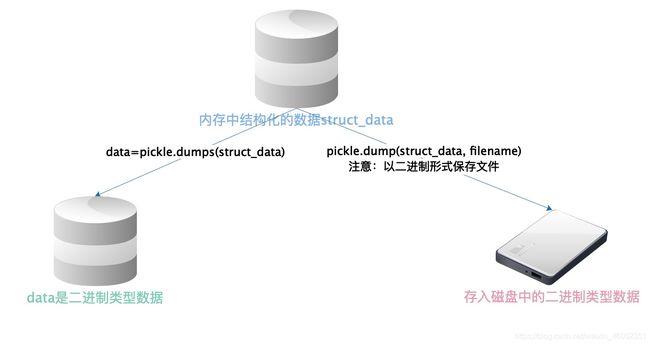
import pickle
struct_data = {
'name': 'json', 'age': 23, 'sex': 'male'}
print(struct_data, type(struct_data))
{'name': 'json', 'age': 23, 'sex': 'male'}
data = pickle.dumps(struct_data)
print(data, type(data))
b'\x80\x03}q\x00(X\x04\x00\x00\x00nameq\x01X\x04\x00\x00\x00jsonq\x02X\x03\x00\x00\x00ageq\x03K\x17X\x03\x00\x00\x00sexq\x04X\x04\x00\x00\x00maleq\x05u.'
data = pickle.loads(data)
print(data, type(data))
{'name': 'json', 'age': 23, 'sex': 'male'}
with open('Pickle序列化对象.pkl', 'wb') as fw:
pickle.dump(struct_data, fw)
with open('Pickle序列化对象.pkl', 'rb') as fr:
pickle = pickle.load(fr)
print(data)
{'name': 'json', 'age': 23, 'sex': 'male'}
hashlib模块
hash是什么
hash是一种算法(Python3.版本里使用hashlib模块代替了md5模块和sha模块,主要提供 SHA1、SHA224、SHA256、SHA384、SHA512、MD5 算法),该算法接受传入的内容,经过运算得到一串hash值。
hash值的特点:
- 只要传入的内容一样,得到的hash值一样,可用于非明文密码传输时密码校验
- 不能由hash值返解成内容,即可以保证非明文密码的安全性
- 只要使用的hash算法不变,无论校验的内容有多大,得到的hash值长度是固定的,可以用于对文本的哈希处理
hash算法其实可以看成如下图所示的一座工厂,工厂接收你送来的原材料,经过加工返回的产品就是hash值

import hashlib
m = hashlib.md5()
m.update('hello'.encode('utf8'))
print(m.hexdigest())
5d41402abc4b2a76b9719d911017c592
m.update('hash'.encode('utf8'))
print(m.hexdigest())
97fa850988687b8ceb12d773347f7712
m2 = hashlib.md5()
m2.update('hellohash'.encode('utf8'))
print(m2.hexdigest())
97fa850988687b8ceb12d773347f7712
m3 = hashlib.md5()
m3.update('hello'.encode('utf8'))
print(m3.hexdigest())
5d41402abc4b2a76b9719d911017c592
撞库破解hash算法加密
hash加密算法虽然看起来很厉害,但是他是存在一定缺陷的,即可以通过撞库可以反解,如下代码所示。
import hashlib
pwd_list = [
'hash3714',
'hash1313',
'hash94139413',
'hash123456',
'123456hash',
'h123ash',
]
def make_pwd_dic(pwd_list):
dic = {
}
for pwd in pwd_list:
m = hashlib.md5()
m.update(pwd.encode('utf-8'))
dic[pwd] = m.hexdigest()
return dic
def break_code(hash_pwd, pwd_dic):
for k, v in pwd_dic.items():
if v == hash_pwd:
print('hash的微信的密码是===>\033[46m%s\033[0m' % k)
hash_pwd = '0562b36c3c5a3925dbe3c4d32a4f2ba2'
break_code(hash_pwd, make_pwd_dic(pwd_list))
hash的微信的密码是===>[46mhash123456[0m
为了防止密码被撞库,我们可以使用python中的另一个hmac 模块,它内部对我们创建key和内容做过某种处理后再加密。
如果要保证hmac模块最终结果一致,必须保证:
- hmac.new括号内指定的初始key一样
- 无论update多少次,校验的内容累加到一起是一样的内容
import hmac
h1 = hmac.new(b'hash')
h1.update(b'hello')
h1.update(b'world')
print(h1.hexdigest())
905f549c5722b5850d602862c34a763e
h2 = hmac.new(b'hash')
h2.update(b'helloworld')
print(h2.hexdigest())
905f549c5722b5850d602862c34a763e
h3 = hmac.new(b'hashhelloworld')
print(h3.hexdigest())
a7e524ade8ac5f7f33f3a39a8f63fd25
logging模块
日志级别
- CRITICAL = 50
- ERROR = 40
- WARNING = 30
- INFO = 20
- DEBUG = 10
- NOTSET = 0
日志打印
import logging
[DEBUG][2019-03-07 16:22:14,853][:4]调试debug
[INFO][2019-03-07 16:22:14,857][:5]消息info
[WARNING][2019-03-07 16:22:14,858][:6]警告warn
[ERROR][2019-03-07 16:22:14,860][:7]错误error
[CRITICAL][2019-03-07 16:22:14,862][:8]严重critical
应用
import os
import logging.config
standard_format = '[%(asctime)s][%(threadName)s:%(thread)d][task_id:%(name)s][%(filename)s:%(lineno)d]' \
'[%(levelname)s][%(message)s]'
simple_format = '[%(levelname)s][%(asctime)s][%(filename)s:%(lineno)d]%(message)s'
id_simple_format = '[%(levelname)s][%(asctime)s] %(message)s'
logfile_dir = 'os.path.dirname(os.path.abspath(__file__))'
logfile_name = 'logfile.log'
if not os.path.isdir(logfile_dir):
os.mkdir(logfile_dir)
logfile_path = os.path.join(logfile_dir, logfile_name)
LOGGING_DIC = {
'version': 1,
'disable_existing_loggers': False,
'formatters': {
'standard': {
'format': standard_format
},
'simple': {
'format': simple_format
},
},
'filters': {
},
'handlers': {
'console': {
'level': 'DEBUG',
'class': 'logging.StreamHandler',
'formatter': 'simple'
},
'default': {
'level': 'DEBUG',
'class': 'logging.handlers.RotatingFileHandler',
'formatter': 'standard',
'filename': logfile_path,
'maxBytes': 1024*1024*5,
'backupCount': 5,
'encoding': 'utf-8',
},
},
'loggers': {
'': {
'handlers': ['default', 'console'],
'level': 'DEBUG',
'propagate': True,
},
},
}
def load_my_logging_cfg():
logging.config.dictConfig(LOGGING_DIC)
logger = logging.getLogger(__name__)
logger.info('It works!')
if __name__ == '__main__':
load_my_logging_cfg()
import time
import logging
import my_logging
logger = logging.getLogger(__name__)
def demo():
logger.debug("start range. time:{}".format(time.time()))
logger.info("中文测试开始。")
for i in range(10):
logger.debug("i:{}".format(i))
time.sleep(0.2)
else:
logger.debug("over range. time:{}".format(time.time()))
logger.info("中文测试结束。")
if __name__ == "__main__":
my_logging.load_my_logging_cfg()
demo()
numpy模块
numpy官方文档:https://docs.scipy.org/doc/numpy/reference/?v=20190307135750
numpy是Python的一种开源的数值计算扩展库。这种库可用来存储和处理大型矩阵,比Python自身的嵌套列表结构要高效的多(该结构也可以用来表示矩阵)。
numpy库有两个作用:
- 区别于list列表,提供了数组操作、数组运算、以及统计分布和简单的数学模型
- 计算速度快,甚至要由于python内置的简单运算,使得其成为pandas、sklearn等模块的依赖包。高级的框架如TensorFlow、PyTorch等,其数组操作也和numpy非常相似。
创建矩阵
矩阵即numpy的ndarray对象,创建矩阵就是把一个列表传入np.array()方法。
import numpy as np
arr = np.array([1, 2, 3])
print(arr, type(arr))
[1 2 3]
print(np.array([[1, 2, 3], [4, 5, 6]]))
[[1 2 3]
[4 5 6]]
print(np.array([[1, 2, 3], [4, 5, 6], [7, 8, 9]]))
[[1 2 3]
[4 5 6]
[7 8 9]]
获取矩阵的行列数
arr = np.array([[1, 2, 3], [4, 5, 6]])
print(arr)
[[1 2 3]
[4 5 6]]
print(arr.shape)
(2, 3)
print(arr.shape[0])
2
print(arr.shape[1])
3
切割矩阵
切分矩阵类似于列表的切割,但是与列表的切割不同的是,矩阵的切割涉及到行和列的切割,但是两者切割的方式都是从索引0开始,并且取头不取尾。
arr = np.array([[1, 2, 3, 4], [5, 6, 7, 8], [9, 10, 11, 12]])
print(arr)
[[ 1 2 3 4]
[ 5 6 7 8]
[ 9 10 11 12]]
print(arr[:, :])
[[ 1 2 3 4]
[ 5 6 7 8]
[ 9 10 11 12]]
print(arr[:1, :])
[[1 2 3 4]]
print(arr[0, [0, 1, 2, 3]])
[1 2 3 4]
print(arr[:, :1])
[[1]
[5]
[9]]
print(arr[(0, 1, 2), 0])
[1 5 9]
print(arr[(0, 1, 2), 0])
[1 5 9]
print(arr[0, 0])
1
print(arr[arr > 5])
[ 6 7 8 9 10 11 12]
print(arr > 5)
[[False False False False]
[False True True True]
[ True True True True]]
矩阵元素替换
矩阵元素的替换,类似于列表元素的替换,并且矩阵也是一个可变类型的数据,即如果对矩阵进行替换操作,会修改原矩阵的元素,所以下面我们用.copy()方法举例矩阵元素的替换。
arr = np.array([[1, 2, 3, 4], [5, 6, 7, 8], [9, 10, 11, 12]])
print(arr)
[[ 1 2 3 4]
[ 5 6 7 8]
[ 9 10 11 12]]
arr1 = arr.copy()
arr1[:1, :] = 0
print(arr1)
[[ 0 0 0 0]
[ 5 6 7 8]
[ 9 10 11 12]]
arr2 = arr.copy()
arr2[arr > 5] = 0
print(arr2)
[[1 2 3 4]
[5 0 0 0]
[0 0 0 0]]
arr3 = arr.copy()
arr3[:, :] = 0
print(arr3)
[[0 0 0 0]
[0 0 0 0]
[0 0 0 0]]
矩阵的合并
arr1 = np.array([[1, 2], [3, 4], [5, 6]])
print(arr1)
[[1 2]
[3 4]
[5 6]]
arr2 = np.array([[7, 8], [9, 10], [11, 12]])
print(arr2)
[[ 7 8]
[ 9 10]
[11 12]]
print(np.hstack((arr1, arr2)))
[[ 1 2 7 8]
[ 3 4 9 10]
[ 5 6 11 12]]
print(np.concatenate((arr1, arr2), axis=1))
[[ 1 2 7 8]
[ 3 4 9 10]
[ 5 6 11 12]]
print(np.vstack((arr1, arr2)))
[[ 1 2]
[ 3 4]
[ 5 6]
[ 7 8]
[ 9 10]
[11 12]]
print(np.concatenate((arr1, arr2), axis=0))
[[ 1 2]
[ 3 4]
[ 5 6]
[ 7 8]
[ 9 10]
[11 12]]
通过函数创建矩阵
arange
print(np.arange(10))
[0 1 2 3 4 5 6 7 8 9]
print(np.arange(1, 5))
[1 2 3 4]
print(np.arange(1, 20, 2))
[ 1 3 5 7 9 11 13 15 17 19]
linspace/logspace
print(np.linspace(0, 20, 5))
[ 0. 5. 10. 15. 20.]
print(np.logspace(0, 20, 5))
[ 1.00000000e+00 1.00000000e+05 1.00000000e+10 1.00000000e+15
1.00000000e+20]
zeros/ones/eye/empty
print(np.zeros((3, 4)))
[[ 0. 0. 0. 0.]
[ 0. 0. 0. 0.]
[ 0. 0. 0. 0.]]
print(np.ones((3, 4)))
[[ 1. 1. 1. 1.]
[ 1. 1. 1. 1.]
[ 1. 1. 1. 1.]]
print(np.eye(3))
[[ 1. 0. 0.]
[ 0. 1. 0.]
[ 0. 0. 1.]]
print(np.empty((4, 4)))
[[ 1.72723371e-077 -2.68678116e+154 3.95252517e-323 0.00000000e+000]
[ 0.00000000e+000 0.00000000e+000 0.00000000e+000 0.00000000e+000]
[ 0.00000000e+000 0.00000000e+000 0.00000000e+000 0.00000000e+000]
[ 0.00000000e+000 0.00000000e+000 0.00000000e+000 1.17248833e-308]]
fromstring/fromfunction
s = 'abcdef'
print(np.fromstring(s, dtype=np.int8))
[ 97 98 99 100 101 102]
def func(i, j):
"""其中i为矩阵的行,j为矩阵的列"""
return i*j
print(np.fromfunction(func, (3, 4)))
[[ 0. 0. 0. 0.]
[ 0. 1. 2. 3.]
[ 0. 2. 4. 6.]]
矩阵的运算
普通矩阵运算
| 运算符 |
说明 |
| + |
两个矩阵对应元素相加 |
| - |
两个矩阵对应元素相减 |
| * |
两个矩阵对应元素相乘 |
| / |
两个矩阵对应元素相除,如果都是整数则取商 |
| % |
两个矩阵对应元素相除后取余数 |
| **n |
单个矩阵每个元素都取n次方,如**2:每个元素都取平方 |
arrarr1 = np.array([[1, 2], [3, 4], [5, 6]])
print(arr1)
[[1 2]
[3 4]
[5 6]]
arr2 = np.array([[7, 8], [9, 10], [11, 12]])
print(arr2)
[[ 7 8]
[ 9 10]
[11 12]]
print(arr1+arr2)
[[ 8 10]
[12 14]
[16 18]]
print(arr1**2)
[[ 1 4]
[ 9 16]
[25 36]]
常用矩阵运算函数
| 矩阵函数 |
详解 |
| np.sin(arr) |
对矩阵arr中每个元素取正弦, s i n ( x ) sin(x) sin(x) |
| np.cos(arr) |
对矩阵arr中每个元素取余弦, c o s ( x ) cos(x) cos(x) |
| np.tan(arr) |
对矩阵arr中每个元素取正切, t a n ( x ) tan(x) tan(x) |
| np.arcsin(arr) |
对矩阵arr中每个元素取反正弦, a r c s i n ( x ) arcsin(x) arcsin(x) |
| np.arccos(arr) |
对矩阵arr中每个元素取反余弦, a r c c o s ( x ) arccos(x) arccos(x) |
| np.arctan(arr) |
对矩阵arr中每个元素取反正切, a r c t a n ( x ) arctan(x) arctan(x) |
| np.exp(arr) |
对矩阵arr中每个元素取指数函数, e x e^x ex |
| np.sqrt(arr) |
对矩阵arr中每个元素开根号 x \sqrt{x} x |
arr = np.array([[1, 2, 3, 4], [5, 6, 7, 8], [9, 10, 11, 12]])
print(arr)
[[ 1 2 3 4]
[ 5 6 7 8]
[ 9 10 11 12]]
print(np.sin(arr))
[[ 0.84147098 0.90929743 0.14112001 -0.7568025 ]
[-0.95892427 -0.2794155 0.6569866 0.98935825]
[ 0.41211849 -0.54402111 -0.99999021 -0.53657292]]
print(np.sqrt(arr))
[[ 1. 1.41421356 1.73205081 2. ]
[ 2.23606798 2.44948974 2.64575131 2.82842712]
[ 3. 3.16227766 3.31662479 3.46410162]]
print(np.arcsin(arr))
[[ 1.57079633 nan nan nan]
[ nan nan nan nan]
[ nan nan nan nan]]
/Applications/anaconda3/lib/python3.6/site-packages/ipykernel_launcher.py:2: RuntimeWarning: invalid value encountered in arcsin
矩阵的点乘
矩阵的点乘必须满足第一个矩阵的列数等于第二个矩阵的行数,即 m ∗ n ⋅ n ∗ m = m ∗ m m*n·{n*m}=m*m m∗n⋅n∗m=m∗m。
arr1 = np.array([[1, 2, 3], [4, 5, 6]])
print(arr1.shape)
(2, 3)
arr2 = np.array([[7, 8], [9, 10], [11, 12]])
print(arr2.shape)
(3, 2)
assert arr1.shape[0] == arr2.shape[1]
print(arr2.shape)
(3, 2)
矩阵的转置
矩阵的转置,相当于矩阵的行和列互换。
arr = np.array([[1, 2, 3], [4, 5, 6]])
print(arr)
[[1 2 3]
[4 5 6]]
print(arr.transpose())
[[1 4]
[2 5]
[3 6]]
print(arr.T)
[[1 4]
[2 5]
[3 6]]
矩阵的逆
矩阵行和列相同时,矩阵才可逆。
arr = np.array([[1, 2, 3], [4, 5, 6], [7, 8, 9]])
print(arr)
[[1 2 3]
[4 5 6]
[7 8 9]]
print(np.linalg.inv(arr))
[[ 3.15251974e+15 -6.30503948e+15 3.15251974e+15]
[ -6.30503948e+15 1.26100790e+16 -6.30503948e+15]
[ 3.15251974e+15 -6.30503948e+15 3.15251974e+15]]
arr = np.eye(3)
print(arr)
[[ 1. 0. 0.]
[ 0. 1. 0.]
[ 0. 0. 1.]]
print(np.linalg.inv(arr))
[[ 1. 0. 0.]
[ 0. 1. 0.]
[ 0. 0. 1.]]
矩阵其他操作
最大最小值
arr = np.array([[1, 2, 3], [4, 5, 6], [7, 8, 9]])
print(arr)
[[1 2 3]
[4 5 6]
[7 8 9]]
print(arr.max())
9
print(arr.min())
1
print(arr.max(axis=0))
[7 8 9]
print(arr.max(axis=1))
[3 6 9]
print(arr.argmax(axis=1))
[2 2 2]
平均值
arr = np.array([[1, 2, 3], [4, 5, 6], [7, 8, 9]])
print(arr)
[[1 2 3]
[4 5 6]
[7 8 9]]
print(arr.mean())
5.0
print(arr.mean(axis=0))
[ 4. 5. 6.]
print(arr.mean(axis=1))
[ 2. 5. 8.]
方差
方差公式为
m e a n ( ∣ x − x . m e a n ( ) ∣ 2 ) mean(|x-x.mean()|^2) mean(∣x−x.mean()∣2)
其中x为矩阵。
arr = np.array([[1, 2, 3], [4, 5, 6], [7, 8, 9]])
print(arr)
[[1 2 3]
[4 5 6]
[7 8 9]]
print(arr.var())
6.66666666667
print(arr.var(axis=0))
[ 6. 6. 6.]
print(arr.var(axis=1))
[ 0.66666667 0.66666667 0.66666667]
标准差
标准差公式为
m e a n ∣ x − x . m e a n ( ) ∣ 2 = x . v a r ( ) \sqrt{mean|x-x.mean()|^2} = \sqrt{x.var()} mean∣x−x.mean()∣2 =x.var()
arr = np.array([[1, 2, 3], [4, 5, 6], [7, 8, 9]])
print(arr)
[[1 2 3]
[4 5 6]
[7 8 9]]
print(arr.std())
2.58198889747
print(arr.std(axis=0))
[ 2.44948974 2.44948974 2.44948974]
print(arr.std(axis=1))
[ 0.81649658 0.81649658 0.81649658]
中位数
arr = np.array([[1, 2, 3], [4, 5, 6], [7, 8, 9]])
print(arr)
[[1 2 3]
[4 5 6]
[7 8 9]]
print(np.median(arr))
5.0
print(np.median(arr, axis=0))
[ 4. 5. 6.]
print(np.median(arr, axis=1))
[ 2. 5. 8.]
矩阵求和
arr = np.array([[1, 2, 3], [4, 5, 6], [7, 8, 9]])
print(arr)
[[1 2 3]
[4 5 6]
[7 8 9]]
print(arr.sum())
45
print(arr.sum(axis=0))
[12 15 18]
print(arr.sum(axis=1))
[ 6 15 24]
累加和
arr = np.array([1, 2, 3, 4, 5])
print(arr)
[1 2 3 4 5]
print(arr.cumsum())
[ 1 3 6 10 15]
numpy.random生成随机数
| 函数名称 |
函数功能 |
参数说明 |
| rand( d 0 , d 1 , ⋯ , d n d_0, d_1, \cdots , d_n d0,d1,⋯,dn) |
产生均匀分布的随机数 |
d n d_n dn为第n维数据的维度 |
| randn( d 0 , d 1 , ⋯ , d n d_0, d_1, \cdots , d_n d0,d1,⋯,dn) |
产生标准正态分布随机数 |
d n d_n dn为第n维数据的维度 |
| randint(low[, high, size, dtype]) |
产生随机整数 |
low:最小值;high:最大值;size:数据个数 |
| random_sample([size]) |
在$[0,1)$内产生随机数 |
size为随机数的shape,可以为元祖或者列表 |
| choice(a[, size]) |
从arr中随机选择指定数据 |
arr为1维数组;size为数据形状 |
rs = np.random.RandomState(1)
print(rs.rand(10))
[ 4.17022005e-01 7.20324493e-01 1.14374817e-04 3.02332573e-01
1.46755891e-01 9.23385948e-02 1.86260211e-01 3.45560727e-01
3.96767474e-01 5.38816734e-01]
np.random.seed(1)
print(np.random.rand(3, 4))
[[ 4.17022005e-01 7.20324493e-01 1.14374817e-04 3.02332573e-01]
[ 1.46755891e-01 9.23385948e-02 1.86260211e-01 3.45560727e-01]
[ 3.96767474e-01 5.38816734e-01 4.19194514e-01 6.85219500e-01]]
print(np.random.rand(3, 4, 5))
[[[ 0.20445225 0.87811744 0.02738759 0.67046751 0.4173048 ]
[ 0.55868983 0.14038694 0.19810149 0.80074457 0.96826158]
[ 0.31342418 0.69232262 0.87638915 0.89460666 0.08504421]
[ 0.03905478 0.16983042 0.8781425 0.09834683 0.42110763]]
[[ 0.95788953 0.53316528 0.69187711 0.31551563 0.68650093]
[ 0.83462567 0.01828828 0.75014431 0.98886109 0.74816565]
[ 0.28044399 0.78927933 0.10322601 0.44789353 0.9085955 ]
[ 0.29361415 0.28777534 0.13002857 0.01936696 0.67883553]]
[[ 0.21162812 0.26554666 0.49157316 0.05336255 0.57411761]
[ 0.14672857 0.58930554 0.69975836 0.10233443 0.41405599]
[ 0.69440016 0.41417927 0.04995346 0.53589641 0.66379465]
[ 0.51488911 0.94459476 0.58655504 0.90340192 0.1374747 ]]]
print(np.random.randn(3, 4))
[[ 0.30017032 -0.35224985 -1.1425182 -0.34934272]
[-0.20889423 0.58662319 0.83898341 0.93110208]
[ 0.28558733 0.88514116 -0.75439794 1.25286816]]
print(np.random.randint(1, 5, 10))
[1 1 1 2 3 1 2 1 3 4]
print(np.random.random_sample((3, 4)))
[[ 0.62169572 0.11474597 0.94948926 0.44991213]
[ 0.57838961 0.4081368 0.23702698 0.90337952]
[ 0.57367949 0.00287033 0.61714491 0.3266449 ]]
arr = np.array([1, 2, 3])
print(np.random.choice(arr, size=2))
[1 3]
pandas模块
pandas官方文档:https://pandas.pydata.org/pandas-docs/stable/?v=20190307135750
pandas基于Numpy,可以看成是处理文本或者表格数据。pandas中有两个主要的数据结构,其中Series数据结构类似于Numpy中的一维数组,DataFrame类似于多维表格数据结构。
pandas是python数据分析的核心模块。它主要提供了五大功能:
- 支持文件存取操作,支持数据库(sql)、html、json、pickle、csv(txt、excel)、sas、stata、hdf等。
- 支持增删改查、切片、高阶函数、分组聚合等单表操作,以及和dict、list的互相转换。
- 支持多表拼接合并操作。
- 支持简单的绘图操作。
- 支持简单的统计分析操作。
Series
import numpy as np
import pandas as pd
arr = np.array([1, 2, 3, 4, np.nan, ])
print(arr)
[ 1. 2. 3. 4. nan]
s = pd.Series(arr)
print(s)
0 1.0
1 2.0
2 3.0
3 4.0
4 NaN
dtype: float64
import random
random.randint(1,10)
1
import numpy as np
np.random.randn(6,4)
array([[-0.42660201, 2.61346133, 0.01214827, -1.43370137],
[-0.28285711, 0.14871693, 0.22235496, -2.63142648],
[ 0.78324411, -0.72633723, -0.23258796, 0.03855565],
[-0.30033472, -1.19873979, -1.72660722, 0.75214317],
[ 1.48194193, 0.11089792, 0.8845003 , -1.26433672],
[ 1.29958399, -1.75092753, 0.06823543, -0.64219199]])
DataFrame
dates = pd.date_range('20190101', periods=6)
print(dates)
DatetimeIndex(['2019-01-01', '2019-01-02', '2019-01-03', '2019-01-04',
'2019-01-05', '2019-01-06'],
dtype='datetime64[ns]', freq='D')
np.random.seed(1)
arr = 10*np.random.randn(6, 4)
print(arr)
[[ 16.24345364 -6.11756414 -5.28171752 -10.72968622]
[ 8.65407629 -23.01538697 17.44811764 -7.61206901]
[ 3.19039096 -2.49370375 14.62107937 -20.60140709]
[ -3.22417204 -3.84054355 11.33769442 -10.99891267]
[ -1.72428208 -8.77858418 0.42213747 5.82815214]
[-11.00619177 11.4472371 9.01590721 5.02494339]]
df = pd.DataFrame(arr, index=dates, columns=['c1', 'c2', 'c3', 'c4'])
df
|
c1 |
c2 |
c3 |
c4 |
| 2019-01-01 |
16.243454 |
-6.117564 |
-5.281718 |
-10.729686 |
| 2019-01-02 |
8.654076 |
-23.015387 |
17.448118 |
-7.612069 |
| 2019-01-03 |
3.190391 |
-2.493704 |
14.621079 |
-20.601407 |
| 2019-01-04 |
-3.224172 |
-3.840544 |
11.337694 |
-10.998913 |
| 2019-01-05 |
-1.724282 |
-8.778584 |
0.422137 |
5.828152 |
| 2019-01-06 |
-11.006192 |
11.447237 |
9.015907 |
5.024943 |
df2 = pd.DataFrame({
'a': 1, 'b': [2, 3], 'c': np.arange(2), 'd': 'hello'})
df2
|
a |
b |
c |
d |
| 0 |
1 |
2 |
0 |
hello |
| 1 |
1 |
3 |
1 |
hello |
DataFrame属性
| 属性 |
详解 |
| dtype |
查看数据类型 |
| index |
查看行序列或者索引 |
| columns |
查看各列的标签 |
| values |
查看数据框内的数据,也即不含表头索引的数据 |
| describe |
查看数据每一列的极值,均值,中位数,只可用于数值型数据 |
| transpose |
转置,也可用T来操作 |
| sort_index |
排序,可按行或列index排序输出 |
| sort_values |
按数据值来排序 |
print(df2.dtypes)
a int64
b int64
c int64
d object
dtype: object
df
|
c1 |
c2 |
c3 |
c4 |
| 2019-01-01 |
16.243454 |
-6.117564 |
-5.281718 |
-10.729686 |
| 2019-01-02 |
8.654076 |
-23.015387 |
17.448118 |
-7.612069 |
| 2019-01-03 |
3.190391 |
-2.493704 |
14.621079 |
-20.601407 |
| 2019-01-04 |
-3.224172 |
-3.840544 |
11.337694 |
-10.998913 |
| 2019-01-05 |
-1.724282 |
-8.778584 |
0.422137 |
5.828152 |
| 2019-01-06 |
-11.006192 |
11.447237 |
9.015907 |
5.024943 |
print(df.index)
DatetimeIndex(['2019-01-01', '2019-01-02', '2019-01-03', '2019-01-04',
'2019-01-05', '2019-01-06'],
dtype='datetime64[ns]', freq='D')
print(df.columns)
Index(['c1', 'c2', 'c3', 'c4'], dtype='object')
print(df.values)
[[ 16.24345364 -6.11756414 -5.28171752 -10.72968622]
[ 8.65407629 -23.01538697 17.44811764 -7.61206901]
[ 3.19039096 -2.49370375 14.62107937 -20.60140709]
[ -3.22417204 -3.84054355 11.33769442 -10.99891267]
[ -1.72428208 -8.77858418 0.42213747 5.82815214]
[-11.00619177 11.4472371 9.01590721 5.02494339]]
df.describe()
|
c1 |
c2 |
c3 |
c4 |
| count |
6.000000 |
6.000000 |
6.000000 |
6.000000 |
| mean |
2.022213 |
-5.466424 |
7.927203 |
-6.514830 |
| std |
9.580084 |
11.107772 |
8.707171 |
10.227641 |
| min |
-11.006192 |
-23.015387 |
-5.281718 |
-20.601407 |
| 25% |
-2.849200 |
-8.113329 |
2.570580 |
-10.931606 |
| 50% |
0.733054 |
-4.979054 |
10.176801 |
-9.170878 |
| 75% |
7.288155 |
-2.830414 |
13.800233 |
1.865690 |
| max |
16.243454 |
11.447237 |
17.448118 |
5.828152 |
df.T
|
2019-01-01 00:00:00 |
2019-01-02 00:00:00 |
2019-01-03 00:00:00 |
2019-01-04 00:00:00 |
2019-01-05 00:00:00 |
2019-01-06 00:00:00 |
| c1 |
16.243454 |
8.654076 |
3.190391 |
-3.224172 |
-1.724282 |
-11.006192 |
| c2 |
-6.117564 |
-23.015387 |
-2.493704 |
-3.840544 |
-8.778584 |
11.447237 |
| c3 |
-5.281718 |
17.448118 |
14.621079 |
11.337694 |
0.422137 |
9.015907 |
| c4 |
-10.729686 |
-7.612069 |
-20.601407 |
-10.998913 |
5.828152 |
5.024943 |
df.sort_index(axis=0)
|
c1 |
c2 |
c3 |
c4 |
| 2019-01-01 |
16.243454 |
-6.117564 |
-5.281718 |
-10.729686 |
| 2019-01-02 |
8.654076 |
-23.015387 |
17.448118 |
-7.612069 |
| 2019-01-03 |
3.190391 |
-2.493704 |
14.621079 |
-20.601407 |
| 2019-01-04 |
-3.224172 |
-3.840544 |
11.337694 |
-10.998913 |
| 2019-01-05 |
-1.724282 |
-8.778584 |
0.422137 |
5.828152 |
| 2019-01-06 |
-11.006192 |
11.447237 |
9.015907 |
5.024943 |
df2.sort_index(axis=1)
|
a |
b |
c |
d |
| 0 |
1 |
2 |
0 |
hello |
| 1 |
1 |
3 |
1 |
hello |
df2.sort_values(by='a')
|
a |
b |
c |
d |
| 0 |
1 |
2 |
0 |
hello |
| 1 |
1 |
3 |
1 |
hello |
DataFrame取值
df
|
c1 |
c2 |
c3 |
c4 |
| 2019-01-01 |
16.243454 |
-6.117564 |
-5.281718 |
-10.729686 |
| 2019-01-02 |
8.654076 |
-23.015387 |
17.448118 |
-7.612069 |
| 2019-01-03 |
3.190391 |
-2.493704 |
14.621079 |
-20.601407 |
| 2019-01-04 |
-3.224172 |
-3.840544 |
11.337694 |
-10.998913 |
| 2019-01-05 |
-1.724282 |
-8.778584 |
0.422137 |
5.828152 |
| 2019-01-06 |
-11.006192 |
11.447237 |
9.015907 |
5.024943 |
df['c2']
2019-01-01 -6.117564
2019-01-02 -23.015387
2019-01-03 -2.493704
2019-01-04 -3.840544
2019-01-05 -8.778584
2019-01-06 11.447237
Freq: D, Name: c2, dtype: float64
df[0:3]
|
c1 |
c2 |
c3 |
c4 |
| 2019-01-01 |
16.243454 |
-6.117564 |
-5.281718 |
-10.729686 |
| 2019-01-02 |
8.654076 |
-23.015387 |
17.448118 |
-7.612069 |
| 2019-01-03 |
3.190391 |
-2.493704 |
14.621079 |
-20.601407 |
loc/iloc
df.loc['2019-01-01':'2019-01-05']
|
c1 |
c2 |
c3 |
c4 |
| 2019-01-01 |
16.243454 |
-6.117564 |
-5.281718 |
-10.729686 |
| 2019-01-02 |
8.654076 |
-23.015387 |
17.448118 |
-7.612069 |
| 2019-01-03 |
3.190391 |
-2.493704 |
14.621079 |
-20.601407 |
| 2019-01-04 |
-3.224172 |
-3.840544 |
11.337694 |
-10.998913 |
| 2019-01-05 |
-1.724282 |
-8.778584 |
0.422137 |
5.828152 |
df
|
c1 |
c2 |
c3 |
c4 |
| 2019-01-01 |
16.243454 |
-6.117564 |
-5.281718 |
-10.729686 |
| 2019-01-02 |
8.654076 |
-23.015387 |
17.448118 |
-7.612069 |
| 2019-01-03 |
3.190391 |
-2.493704 |
14.621079 |
-20.601407 |
| 2019-01-04 |
-3.224172 |
-3.840544 |
11.337694 |
-10.998913 |
| 2019-01-05 |
-1.724282 |
-8.778584 |
0.422137 |
5.828152 |
| 2019-01-06 |
-11.006192 |
11.447237 |
9.015907 |
5.024943 |
df.values
array([[ 16.24345364, -6.11756414, -5.28171752, -10.72968622],
[ 8.65407629, -23.01538697, 17.44811764, -7.61206901],
[ 3.19039096, -2.49370375, 14.62107937, -20.60140709],
[ -3.22417204, -3.84054355, 11.33769442, -10.99891267],
[ -1.72428208, -8.77858418, 0.42213747, 5.82815214],
[-11.00619177, 11.4472371 , 9.01590721, 5.02494339]])
print(df.iloc[2, 1])
-2.49370375477
print(df.iloc[2, 1])
-2.49370375477
df.iloc[1:4, 1:4]
|
c2 |
c3 |
c4 |
| 2019-01-02 |
-23.015387 |
17.448118 |
-7.612069 |
| 2019-01-03 |
-2.493704 |
14.621079 |
-20.601407 |
| 2019-01-04 |
-3.840544 |
11.337694 |
-10.998913 |
df
|
c1 |
c2 |
c3 |
c4 |
| 2019-01-01 |
16.243454 |
-6.117564 |
-5.281718 |
-10.729686 |
| 2019-01-02 |
8.654076 |
-23.015387 |
17.448118 |
-7.612069 |
| 2019-01-03 |
3.190391 |
-2.493704 |
14.621079 |
-20.601407 |
| 2019-01-04 |
-3.224172 |
-3.840544 |
11.337694 |
-10.998913 |
| 2019-01-05 |
-1.724282 |
-8.778584 |
0.422137 |
5.828152 |
| 2019-01-06 |
-11.006192 |
11.447237 |
9.015907 |
5.024943 |
使用逻辑判断取值
df[df['c1'] > 0]
|
c1 |
c2 |
c3 |
c4 |
| 2019-01-01 |
16.243454 |
-6.117564 |
-5.281718 |
-10.729686 |
| 2019-01-02 |
8.654076 |
-23.015387 |
17.448118 |
-7.612069 |
| 2019-01-03 |
3.190391 |
-2.493704 |
14.621079 |
-20.601407 |
DataFrame值替换
df
|
c1 |
c2 |
c3 |
c4 |
| 2019-01-01 |
16.243454 |
-6.117564 |
-5.281718 |
-10.729686 |
| 2019-01-02 |
8.654076 |
-23.015387 |
17.448118 |
-7.612069 |
| 2019-01-03 |
3.190391 |
-2.493704 |
14.621079 |
-20.601407 |
| 2019-01-04 |
-3.224172 |
-3.840544 |
11.337694 |
-10.998913 |
| 2019-01-05 |
-1.724282 |
-8.778584 |
0.422137 |
5.828152 |
| 2019-01-06 |
-11.006192 |
11.447237 |
9.015907 |
5.024943 |
df.iloc[0:3, 0:2] = 0
df
|
c1 |
c2 |
c3 |
c4 |
| 2019-01-01 |
0.000000 |
0.000000 |
-5.281718 |
-10.729686 |
| 2019-01-02 |
0.000000 |
0.000000 |
17.448118 |
-7.612069 |
| 2019-01-03 |
0.000000 |
0.000000 |
14.621079 |
-20.601407 |
| 2019-01-04 |
-3.224172 |
-3.840544 |
11.337694 |
-10.998913 |
| 2019-01-05 |
-1.724282 |
-8.778584 |
0.422137 |
5.828152 |
| 2019-01-06 |
-11.006192 |
11.447237 |
9.015907 |
5.024943 |
df
|
c1 |
c2 |
c3 |
c4 |
| 2019-01-01 |
16.243454 |
-6.117564 |
-5.281718 |
-10.729686 |
| 2019-01-02 |
8.654076 |
-23.015387 |
17.448118 |
-7.612069 |
| 2019-01-03 |
3.190391 |
-2.493704 |
14.621079 |
-20.601407 |
| 2019-01-04 |
-3.224172 |
-3.840544 |
11.337694 |
-10.998913 |
| 2019-01-05 |
-1.724282 |
-8.778584 |
0.422137 |
5.828152 |
| 2019-01-06 |
-11.006192 |
11.447237 |
9.015907 |
5.024943 |
df[df['c1'] > 0] = 100
df
|
c1 |
c2 |
c3 |
c4 |
| 2019-01-01 |
100.000000 |
100.000000 |
100.000000 |
100.000000 |
| 2019-01-02 |
100.000000 |
100.000000 |
100.000000 |
100.000000 |
| 2019-01-03 |
100.000000 |
100.000000 |
100.000000 |
100.000000 |
| 2019-01-04 |
-3.224172 |
-3.840544 |
11.337694 |
-10.998913 |
| 2019-01-05 |
-1.724282 |
-8.778584 |
0.422137 |
5.828152 |
| 2019-01-06 |
-11.006192 |
11.447237 |
9.015907 |
5.024943 |
读取CSV文件
from io import StringIO
test_data = '''
5.1,,1.4,0.2
4.9,3.0,1.4,0.2
4.7,3.2,,0.2
7.0,3.2,4.7,1.4
6.4,3.2,4.5,1.5
6.9,3.1,4.9,
,,,
'''
test_data = StringIO(test_data)
df = pd.read_csv(test_data)
df = pd.read_excel(test_data)
df.columns = ['c1', 'c2', 'c3', 'c4']
df
|
c1 |
c2 |
c3 |
c4 |
| 0 |
4.9 |
3.0 |
1.4 |
0.2 |
| 1 |
4.7 |
3.2 |
NaN |
0.2 |
| 2 |
7.0 |
3.2 |
4.7 |
1.4 |
| 3 |
6.4 |
3.2 |
4.5 |
1.5 |
| 4 |
6.9 |
3.1 |
4.9 |
NaN |
| 5 |
NaN |
NaN |
NaN |
NaN |
处理丢失数据
df.isnull()
|
c1 |
c2 |
c3 |
c4 |
| 0 |
False |
False |
False |
False |
| 1 |
False |
False |
True |
False |
| 2 |
False |
False |
False |
False |
| 3 |
False |
False |
False |
False |
| 4 |
False |
False |
False |
True |
| 5 |
True |
True |
True |
True |
print(df.isnull().sum())
c1 1
c2 1
c3 2
c4 2
dtype: int64
df
|
c1 |
c2 |
c3 |
c4 |
| 0 |
4.9 |
3.0 |
1.4 |
0.2 |
| 1 |
4.7 |
3.2 |
NaN |
0.2 |
| 2 |
7.0 |
3.2 |
4.7 |
1.4 |
| 3 |
6.4 |
3.2 |
4.5 |
1.5 |
| 4 |
6.9 |
3.1 |
4.9 |
NaN |
| 5 |
NaN |
NaN |
NaN |
NaN |
df.dropna(axis=0)
|
c1 |
c2 |
c3 |
c4 |
| 0 |
4.9 |
3.0 |
1.4 |
0.2 |
| 2 |
7.0 |
3.2 |
4.7 |
1.4 |
| 3 |
6.4 |
3.2 |
4.5 |
1.5 |
df.dropna(axis=1)
df.dropna(how='all')
|
c1 |
c2 |
c3 |
c4 |
| 0 |
4.9 |
3.0 |
1.4 |
0.2 |
| 1 |
4.7 |
3.2 |
NaN |
0.2 |
| 2 |
7.0 |
3.2 |
4.7 |
1.4 |
| 3 |
6.4 |
3.2 |
4.5 |
1.5 |
| 4 |
6.9 |
3.1 |
4.9 |
NaN |
df.dropna(thresh=4)
|
c1 |
c2 |
c3 |
c4 |
| 0 |
4.9 |
3.0 |
1.4 |
0.2 |
| 2 |
7.0 |
3.2 |
4.7 |
1.4 |
| 3 |
6.4 |
3.2 |
4.5 |
1.5 |
df.dropna(subset=['c2'])
|
c1 |
c2 |
c3 |
c4 |
| 0 |
4.9 |
3.0 |
1.4 |
0.2 |
| 1 |
4.7 |
3.2 |
NaN |
0.2 |
| 2 |
7.0 |
3.2 |
4.7 |
1.4 |
| 3 |
6.4 |
3.2 |
4.5 |
1.5 |
| 4 |
6.9 |
3.1 |
4.9 |
NaN |
df
|
c1 |
c2 |
c3 |
c4 |
| 0 |
4.9 |
3.0 |
1.4 |
0.2 |
| 1 |
4.7 |
3.2 |
NaN |
0.2 |
| 2 |
7.0 |
3.2 |
4.7 |
1.4 |
| 3 |
6.4 |
3.2 |
4.5 |
1.5 |
| 4 |
6.9 |
3.1 |
4.9 |
NaN |
| 5 |
NaN |
NaN |
NaN |
NaN |
df.fillna(value=10)
|
c1 |
c2 |
c3 |
c4 |
| 0 |
4.9 |
3.0 |
1.4 |
0.2 |
| 1 |
4.7 |
3.2 |
10.0 |
0.2 |
| 2 |
7.0 |
3.2 |
4.7 |
1.4 |
| 3 |
6.4 |
3.2 |
4.5 |
1.5 |
| 4 |
6.9 |
3.1 |
4.9 |
10.0 |
| 5 |
10.0 |
10.0 |
10.0 |
10.0 |
导入导出数据
使用df = pd.read_csv(filename)读取文件,使用df.to_csv(filename)保存文件。
合并数据
df1 = pd.DataFrame(np.zeros((3, 4)))
df1
|
0 |
1 |
2 |
3 |
| 0 |
0.0 |
0.0 |
0.0 |
0.0 |
| 1 |
0.0 |
0.0 |
0.0 |
0.0 |
| 2 |
0.0 |
0.0 |
0.0 |
0.0 |
df2 = pd.DataFrame(np.ones((3, 4)))
df2
|
0 |
1 |
2 |
3 |
| 0 |
1.0 |
1.0 |
1.0 |
1.0 |
| 1 |
1.0 |
1.0 |
1.0 |
1.0 |
| 2 |
1.0 |
1.0 |
1.0 |
1.0 |
pd.concat((df1, df2), axis=0)
|
0 |
1 |
2 |
3 |
| 0 |
0.0 |
0.0 |
0.0 |
0.0 |
| 1 |
0.0 |
0.0 |
0.0 |
0.0 |
| 2 |
0.0 |
0.0 |
0.0 |
0.0 |
| 0 |
1.0 |
1.0 |
1.0 |
1.0 |
| 1 |
1.0 |
1.0 |
1.0 |
1.0 |
| 2 |
1.0 |
1.0 |
1.0 |
1.0 |
pd.concat((df1, df2), axis=1)
|
0 |
1 |
2 |
3 |
0 |
1 |
2 |
3 |
| 0 |
0.0 |
0.0 |
0.0 |
0.0 |
1.0 |
1.0 |
1.0 |
1.0 |
| 1 |
0.0 |
0.0 |
0.0 |
0.0 |
1.0 |
1.0 |
1.0 |
1.0 |
| 2 |
0.0 |
0.0 |
0.0 |
0.0 |
1.0 |
1.0 |
1.0 |
1.0 |
df1.append(df2)
|
0 |
1 |
2 |
3 |
| 0 |
0.0 |
0.0 |
0.0 |
0.0 |
| 1 |
0.0 |
0.0 |
0.0 |
0.0 |
| 2 |
0.0 |
0.0 |
0.0 |
0.0 |
| 0 |
1.0 |
1.0 |
1.0 |
1.0 |
| 1 |
1.0 |
1.0 |
1.0 |
1.0 |
| 2 |
1.0 |
1.0 |
1.0 |
1.0 |
读取sql语句
import numpy as np
import pandas as pd
import pymysql
def conn(sql):
conn = pymysql.connect(
host="localhost",
port=3306,
user="root",
passwd="123",
db="db1",
)
try:
data = pd.read_sql(sql, con=conn)
return data
except Exception as e:
print("SQL is not correct!")
finally:
conn.close()
sql = "select * from test1 limit 0, 10"
data = conn(sql)
print(data.columns.tolist())
print(data)
matplotlib模块
matplotlib官方文档:https://matplotlib.org/contents.html?v=20190307135750
matplotlib是一个绘图库,它可以创建常用的统计图,包括条形图、箱型图、折线图、散点图和直方图。
条形图
import matplotlib.pyplot as plt
from matplotlib.font_manager import FontProperties
%matplotlib inline
font = FontProperties(fname='/Library/Fonts/Heiti.ttc')
plt.style.use('ggplot')
classes = ['3班', '4班', '5班', '6班']
classes_index = range(len(classes))
print(list(classes_index))
[0, 1, 2, 3]
student_amounts = [66, 55, 45, 70]
fig = plt.figure()
ax1 = fig.add_subplot(1, 1, 1)
ax1.bar(classes_index, student_amounts, align='center', color='darkblue')
ax1.xaxis.set_ticks_position('bottom')
ax1.yaxis.set_ticks_position('left')
plt.xticks(classes_index, classes, rotation=0,
fontsize=13, fontproperties=font)
plt.xlabel('班级', fontproperties=font, fontsize=15)
plt.ylabel('学生人数', fontproperties=font, fontsize=15)
plt.title('班级-学生人数', fontproperties=font, fontsize=20)
plt.show()
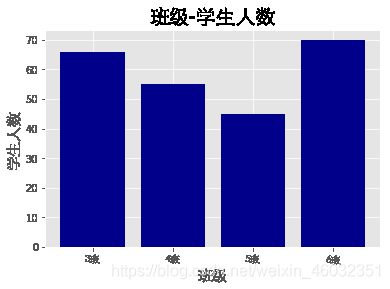
直方图
import numpy as np
import matplotlib.pyplot as plt
from matplotlib.font_manager import FontProperties
%matplotlib inline
font = FontProperties(fname='/Library/Fonts/Heiti.ttc')
plt.style.use('ggplot')
mu1, mu2, sigma = 50, 100, 10
x1 = mu1+sigma*np.random.randn(10000)
print(x1)
[59.00855949 43.16272141 48.77109774 ... 57.94645859 54.70312714
58.94125528]
x2 = mu2+sigma*np.random.randn(10000)
print(x2)
[115.19915511 82.09208214 110.88092454 ... 95.0872103 104.21549068
133.36025251]
fig = plt.figure()
ax1 = fig.add_subplot(121)
ax1.hist(x1, bins=50, color='darkgreen')
ax2 = fig.add_subplot(122)
ax2.hist(x2, bins=50, color='orange')
fig.suptitle('两个正态分布', fontproperties=font, fontweight='bold', fontsize=15)
ax1.set_title('绿色的正态分布', fontproperties=font)
ax2.set_title('橙色的正态分布', fontproperties=font)
plt.show()
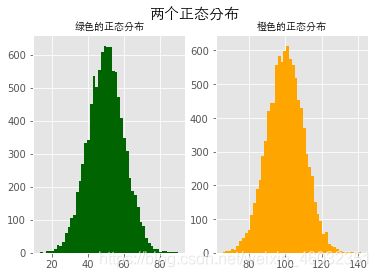
折线图
import numpy as np
from numpy.random import randn
import matplotlib.pyplot as plt
from matplotlib.font_manager import FontProperties
%matplotlib inline
font = FontProperties(fname='/Library/Fonts/Heiti.ttc')
plt.style.use('ggplot')
np.random.seed(1)
plot_data1 = randn(40).cumsum()
print(plot_data1)
[ 1.62434536 1.01258895 0.4844172 -0.58855142 0.2768562 -2.02468249
-0.27987073 -1.04107763 -0.72203853 -0.97140891 0.49069903 -1.56944168
-1.89185888 -2.27591324 -1.1421438 -2.24203506 -2.41446327 -3.29232169
-3.25010794 -2.66729273 -3.76791191 -2.6231882 -1.72159748 -1.21910314
-0.31824719 -1.00197505 -1.12486527 -2.06063471 -2.32852279 -1.79816732
-2.48982807 -2.8865816 -3.5737543 -4.41895994 -5.09020607 -5.10287067
-6.22018102 -5.98576532 -4.32596314 -3.58391898]
plot_data2 = randn(40).cumsum()
plot_data3 = randn(40).cumsum()
plot_data4 = randn(40).cumsum()
plt.plot(plot_data1, marker='o', color='red', linestyle='-', label='红实线')
plt.plot(plot_data2, marker='x', color='orange', linestyle='--', label='橙虚线')
plt.plot(plot_data3, marker='*', color='yellow', linestyle='-.', label='黄点线')
plt.plot(plot_data4, marker='s', color='green', linestyle=':', label='绿点图')
plt.legend(loc='best', prop=font)
plt.show()
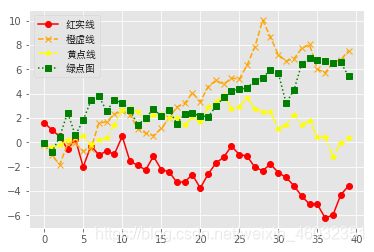
散点图+直线图
import numpy as np
from numpy.random import randn
import matplotlib.pyplot as plt
from matplotlib.font_manager import FontProperties
%matplotlib inline
font = FontProperties(fname='/Library/Fonts/Heiti.ttc')
plt.style.use('ggplot')
x = np.arange(1, 20, 1)
print(x)
[ 1 2 3 4 5 6 7 8 9 10 11 12 13 14 15 16 17 18 19]
np.random.seed(1)
y_linear = x+10*np.random.randn(19)
print(y_linear)
[ 17.24345364 -4.11756414 -2.28171752 -6.72968622 13.65407629
-17.01538697 24.44811764 0.38793099 12.19039096 7.50629625
25.62107937 -8.60140709 9.77582796 10.15945645 26.33769442
5.00108733 15.27571792 9.22141582 19.42213747]
y_quad = x**2+10*np.random.randn(19)
print(y_quad)
[ 6.82815214 -7.00619177 20.4472371 25.01590721 30.02494339
45.00855949 42.16272141 62.77109774 71.64230566 97.3211192
126.30355467 137.08339248 165.03246473 189.128273 216.54794359
249.28753869 288.87335401 312.82689651 363.34415698]
fig = plt.figure()
ax1 = fig.add_subplot(121)
plt.scatter(x, y_linear, s=30, color='r', label='蓝点')
plt.scatter(x, y_quad, s=100, color='b', label='红点')
ax2 = fig.add_subplot(122)
plt.plot(x, y_linear, color='r')
plt.plot(x, y_quad, color='b')
plt.xlim(min(x)-1, max(x)+1)
plt.ylim(min(y_quad)-10, max(y_quad)+10)
fig.suptitle('散点图+直线图', fontproperties=font, fontsize=20)
ax1.set_title('散点图', fontproperties=font)
ax1.legend(prop=font)
ax2.set_title('直线图', fontproperties=font)
plt.show()
